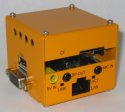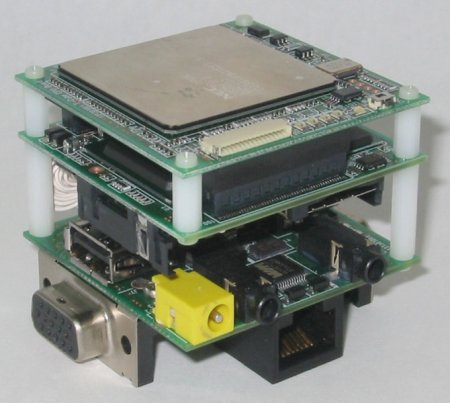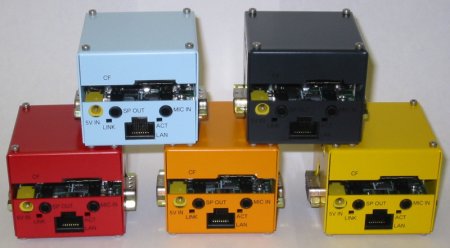Linux tools ship for Tangerine cube and its T-Engine board
Mar 22, 2005 — by Henry Kingman — from the LinuxDevices Archive — views Lineo Solutions says its embedded Linux tools now support a tiny T-Engine-compliant board from Shimafuji. The Shimafuji SEMC5701 board is powered by a MIPS-based SoC from NEC, and is best known for its use in the wall-wart-sized Teacube, T-Cube, or Tangerine Cube from Personal Media Corp.
Lineo Solutions says its embedded Linux tools now support a tiny T-Engine-compliant board from Shimafuji. The Shimafuji SEMC5701 board is powered by a MIPS-based SoC from NEC, and is best known for its use in the wall-wart-sized Teacube, T-Cube, or Tangerine Cube from Personal Media Corp.
(Click for larger view of PMC's Tangerine Cube)
Lineo Solutions describes its uLinux Elite as an integrated cross-platform development environment that supports various target platform through BSP plugins. The company's BSP for the SEMC5701 is based on a kernel patch for NEC's Vr5701 that Lineo Solutions contributed to CELF (Consumer Electronics Linux Forum) in 2004, it says.

Shimafuji's SEMC5701 complies with the T-Engine standard
(Click to enlarge)
Shimafuji's SEMC5701 measures just 2.05 x 2.05 x 1.77 inches (52 x 52 x 48mm). It is based on an NEC Vr5701, clocked at 266MHz or 333MHz. It includes 16MB of Flash, along with 64MB of RAM. I/O interfaces include 10/100 Ethernet, USB, CompactFlash, AC97 audio, and a D-sub 9 RS-232 serial port. The board also offers a D-sub 15 video port, and supports VGA (640 x 480), XGA (800 x 600), and SXGA (1024 x 768) resolutions. It includes an RV5C348B real-time clock, and appears to have a DIP switch for toggling “Endian-ness.” The board accepts 5V DC input, and operates at 0 to 35 degrees Celsius.
The Lineo Solutions BSP for the SEMC5701 is based on a 2.4.20 CELF Linux kernel, with Lineo's patch for the Vr5701. It also includes a Linux 2.6.6 kernel, Lineo Solutions says.
The BSP includes drivers for various interfaces on the Vr5701 chip, including the UART, CompactFlash interface, and PCI bus. It also includes drivers for peripherals on the SEMC5701 board, including the Flash interface (RC28F128J3A-150), RTC (Ricoh RV5C348B), audio (Wolfson WM9707CF/V), Graphics controller (SMI SM722GX040000AB), Ethernet (Intel GD82559ERSL3DG), USB1.0 (NEC uPD720101F), and LED (GPIO).
Additionally, the uLinux Elite environment includes 69 verified packages necessary for embedded Linux development, according to Lineo Solutions, such as glibc, busybox, and gdb.

PMC's T-Cube supports lots of colors besides tangerine
(Click to enlarge)
The Shimafuji SEMC5701 board is best known for its use in Personal Media Corp's Teacube or T-cube, introduced in June of 2004. The T-Cube, which targets kiosk applications, supports embedded Linux, thanks to Lineo Solutions's Vr5701 patch. However, according to Personal Media Corp., it was originally intended to demonstrate the T-Engine embedded environment.
T-Engine is an open standard that defines the configuration of a target system processor board, including external dimensions, and expansion interfaces. It is overseen by the T-Engine Forum, established in 2002. T-Engine was designed to support TRON, a highly fragmented embedded operating system used in myriad consumer electronics devices in Asia. However, MontaVista, Microsoft, and possibly other vendors have joined the Forum to advocate for support for their respective embedded operating systems as well. (For further details, read our news item about T-Engine and T-Linux.)
Lineo Solutions, a Linux vendor in Japan formerly affiliated with Lineo and Metroworks, has been among CELF's most active contributors, previously contributing patches for Renases SH-Mobile (SH7303) and Renesas Camelot (SH7760) chips, and realtime i386, among others. Lineo Solutions has also contributed BSPs to CELF, including BSPs for Via's Epia-ME6000 mini-ITX board and the Renases MS7760CP01P development board for Camelot.
This article was originally published on LinuxDevices.com and has been donated to the open source community by QuinStreet Inc. Please visit LinuxToday.com for up-to-date news and articles about Linux and open source.